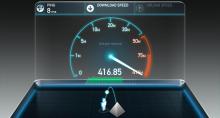
For the past four consecutive years, community owned and/or operated broadband infrastructure has proven to be a key ingredient in the makings of some of the fastest Internet Service Providers (ISPs) in the nation.
As was the case last year, PCMag’s recently released Top 10 list of “The Fastest ISPs of 2022” feature operators that are either municipal broadband networks or use city-owned fiber or conduit to deliver service across whole or parts of their footprint (with the exception of this year’s ninth-place finisher). Another way of saying that is: not one of 10 fastest networks in the nation are owned or operated by the major national ISPs, many of whom have embarked on an aggressive lobbying campaign to misinform public officials in particular and the public in general on the viability and successes of municipal broadband and local partnerships.
After ranking the major ISPs in their own slower category, PCMag turns to “talk about real speed.”
For that, you don’t go to the big guys … Higher speeds are found in smaller, localized ISPs.
Need for Speed? Look to Local ISPs and Munis
After PCMag compiled a year’s worth of speed tests to analyze which ISPs offer the fastest download and upload speeds, Sonic – a California-based independent ISP – came out on top this year, having “posted the highest number we have ever seen in our test results. Because the uploads this company offers are, on average, eclipsing download speeds—by a lot.”
Catapulting to the top of this year’s list (from 10th place last year), Sonic is a privately-owned company that uses publicly owned conduit in Brentwood, California.
The reason is 10-Gigabit service. Sonic offers it, doesn’t cap it, and it starts at just $40 a month. Yet if Sonic’s uploads were just 1/10th of that speed, the company would still win the title of Fastest ISP handily.
Moving up one spot this year to be crowned the second-fastest ISP in the nation is NextLight, the municipal network that serves the city of Longmont, Colo. As PCMag notes, NextLight “has placed third or fourth on this list for years (and) if Sonic’s boost this year is a blip, Nextlight’s consistency could put it on top in 2023.”

Hotwire, which came in third this year, uses public fiber in Salisbury, North Carolina, followed by the municipal network in Fort Collins, known as Connexion with ALLO Communications, a prominent player in a public-private partnership space, closing out the Top 5.
The next fastest five ISPs include Ting and eighth-place Google Fiber, both of whom lease city-owned fiber to operate in places like Huntsville, Alabama and Westminster, Maryland.

Sandwiched in between those two is EPB Fiber, the municipal network in Chattanooga. This year EPB was ranked the seventh fastest ISP in the nation, one-spot lower than last year. (But, imagine how much further up the list EPB would be if PCMag took long-term community-benefit factors in account, such as providing students with free symmetrical connectivity for all qualifying low-income households in their service area or a $2.7 billion return-on-investment Chattanooga has enjoyed over the past decade thanks to its municipal fiber network).
The ninth-fastest ISP, MetroNet, is the only ISP on the Top 10 list that is not a municipal network or leasing access on publicly built infrastructure. But, in 2014 MetroNet did buy the fiber-to-the-home network built by Crawfordsville Electric Light & Power (CEL&P) in Indiana largely because CEL&P did not launch an effective marketing campaign crucial for achieving a sustainable take-rate.
Rounding out the Top 10 list is Empire Access, which uses the open access Southern Tier Network to deliver fiber connectivity to three counties in New York. And although the municipal network in Cedar Falls topped the list in 2020, this year’s list gave them an honorable mention because “local ISPs like CFU really shine.” Cedar Falls didn’t make the cut for the 2022 list, PCMag notes, because “this year we didn’t get enough tests to include it.”
Other Notable Takeaways
Besides ranking the fastest ISPs – which includes state-by-state, regional, and even global comparisons – PCMag also points out something we are keen to remind our readers:
“Although there are a large number of ISPs in the US, how many do you actually have available to you in your home or business? If you can say more than one, you’re lucky. Competition is not fierce on a local level in most places. Though when it is a contest, it can be brutal—in a way that benefits consumers with higher throughput and lower prices. If you have the ability to choose among multiple providers, that's a great thing.”
The report goes on to single out Frontier. While the company was ranked #1 in speed among the major ISPs, PCMag offered a cautionary note:
In May 2021, the Federal Trade Commission filed a lawsuit because Frontier failed to deliver DSL Internet speeds for which consumers paid and were promised. That case was settled this year with the company admitting no wrongdoing, but agreeing to pay millions back to customers and to install $50+ million in new high-speed fiber for up to 60,000 customers in California. ‘We settled the lawsuit in good faith to put it behind us so we could focus on our business—that’s in the best interest of all our stakeholders, and especially our customers,’ the company said. Frontier also recently emerged from a 2020 bankruptcy filing.
We'll see how things look next year, but these facts coupled with how poorly Frontier fared in our most recent PCMag Readers’ Choice Survey of ISPs—ranking toward the bottom of almost every category—give us pause.
Methodology and Additional Lessons
As has been the case since 2011, PCMag uses a formula that takes 80 percent of download speed and 20 percent of upload speed to calculate the PCMag Speed Index (PSI).
This year’s analysis was based on 833,701 test results between June 1, 2021 and June 7, 2022, which was narrowed down to the 277,046 tests that originated in the United States.
As we have noted in previous reporting on PCMag’s list, it clearly privileges download speeds despite the increasing importance of upload speeds for a growing number of applications households are using nowadays. So, it’s almost certain that if they gave equal weight to download and upload speeds, even more municipally-run networks would vie for a spot on the list, as most municipal networks offer symmetrical speeds.

Another caveat to note is that the minimum threshold to be considered for PCMag’s rankings is set at 100 tests. But, given the small size of most municipal networks, and absent a subscriber outreach campaign, PCMag’s minimum threshold serves as a de facto barrier for entry.
Finally, and to PCMag’s credit, the outlet explicitly reminds readers that their “data does not include any information about plan types, tiers of service, data caps, pricing, or things like customer service … this story is about the fastest ISPs, not the companies that treat their customers the best, or the ones you can trust the most.”
There are a variety of other factors to consider when judging the quality, usefulness, and value of networks, which includes, but is not limited to, affordability, transparency, reliability, underlying technology, oversubscription rates and congestion, customer service, reinvestment, and digital inclusion. And that’s why we favor locally-controlled, publicly-owned networks because they tend to not only offer the fastest connectivity speeds but also outperform the major ISPs in all of the above-mentioned categories as well.
Header image of Speed Test courtesy of Flickr user Lars Ploughmann, Attribution-ShareAlike 2.0 Generic (CC BY-SA 2.0)
Inline image of NextLight logo courtesy of NextLight, no copyright infringement is intended
Inline image of EPB Fiber logo courtesy of EPB Fiber, no copyright infringement is intended
Inline image of PCMag Fastest ISP logo of PCMag, no copyright infringement is intended







